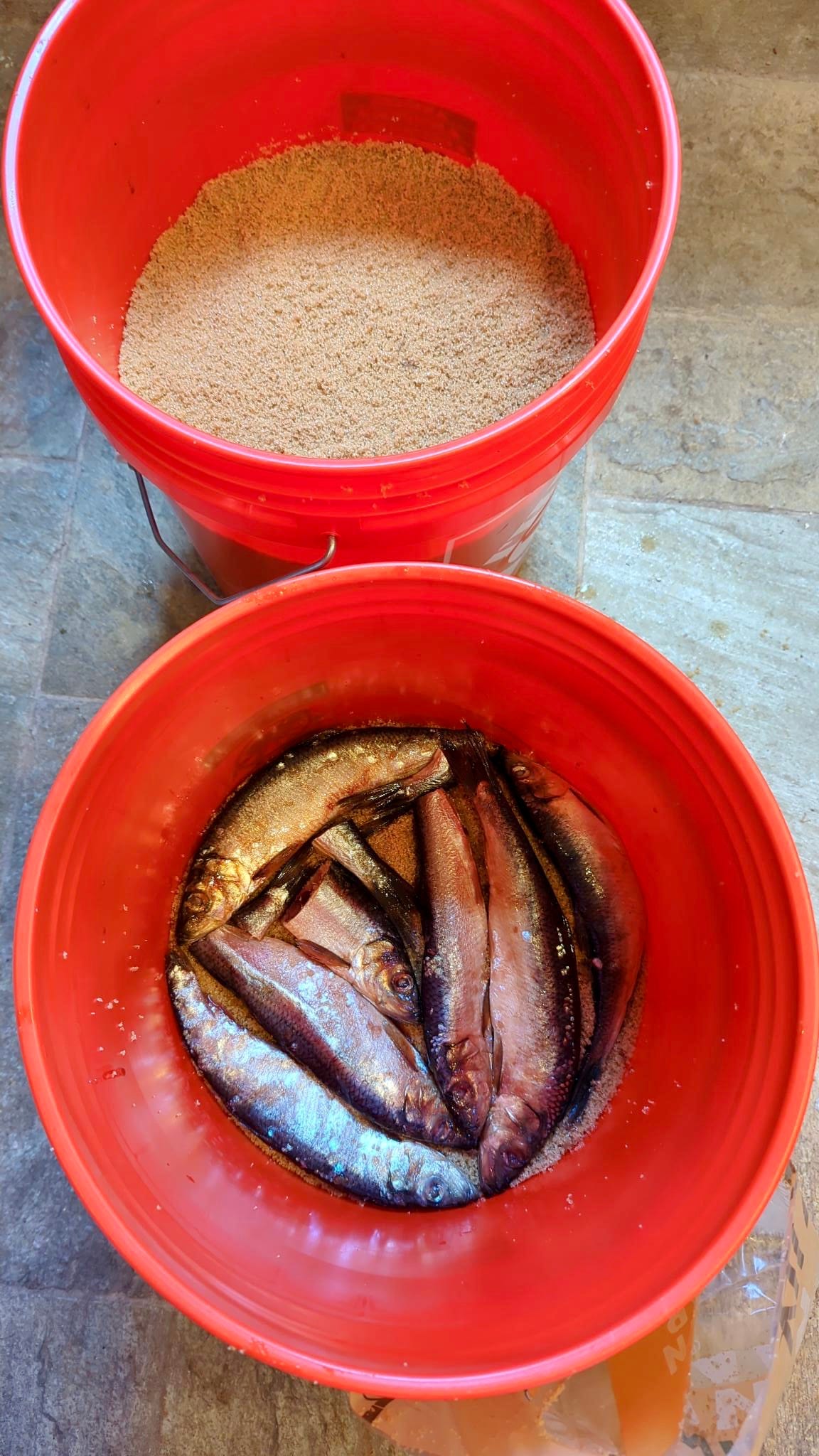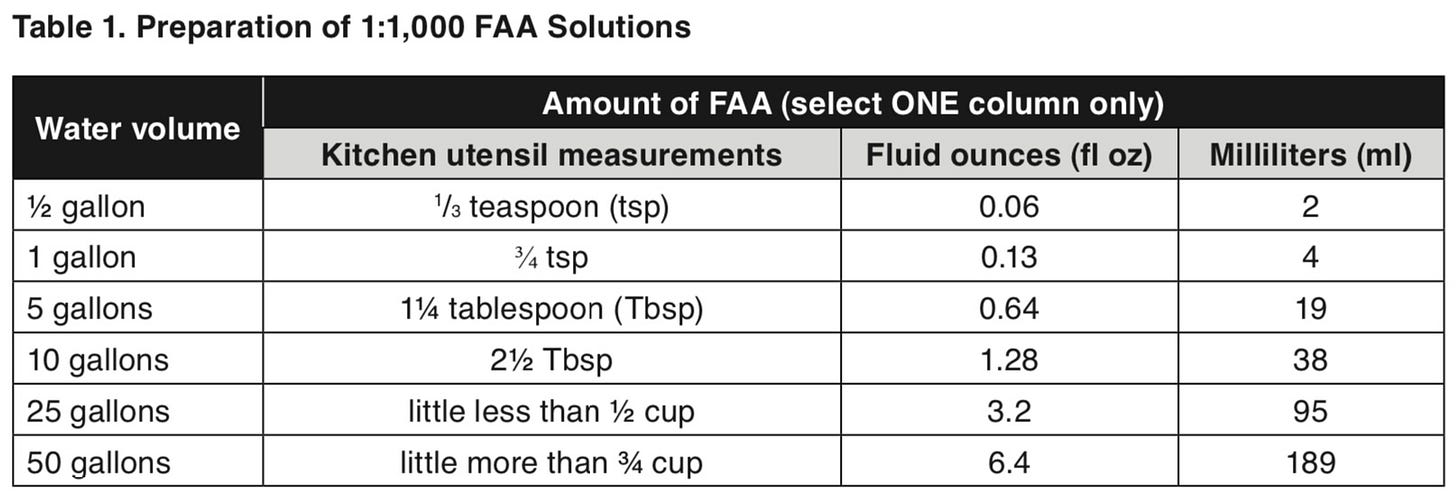Got Fish? Make KNF Fish Amino Acids
Want a natural boost in nitrogen and growth? How about a fish fertilizer with little smell? I got the solution for you, my fig friends! 👀

Korean Natural Farming (KNF) is back helping us again with a really lovely input — Fish Amino Acids (FAA). This product is rich and full of growth-promoting benefits. It also is low-odor, you can literally ferment this in your house and not smell a thing. I know this because I have had two buckets of it in my kitchen for a year!
This is the product you want in growth phases as it is full of amino acids which help young plants that are not yet able to fully manufacture their own amino acids. These amino acids will help to rapidly grow leafy material. FAA also provides nitrogen. This source of nitrogen delivers just enough for optimal uptake and chlorophyll production. It does not leach, runoff, or pollute, but quite the opposite, it improves soil quality by feeding microorganisms and it causes no harm to water systems. It ultimately helps to improve nutrient uptake.
It is excellent for promoting growth in seedlings and rooting cuttings. I use it all the time for my fig tree cuttings I root indoors and there is no lingering fish smell with it. I also use it in the spring on my potted trees to help give them a growth boost as they are waking up.
Because it is so rich and concentrated, it has a high dilution of 1:1000 (FAA:water), though can go up to 1:500 if desired. It does smell like fish when you open the lid, but it smells like a type of fish product you would cook with, maybe like a fishy soy sauce. And with the high dilution, there is very little scent that remains beyond the initial watering time.
One quart of FAA will make 1,000 quarts, (or 250 gallons!!), of diluted solution. It is also shelf-stable and lasts a long time. So this is a product that goes far and is well worth it in my opinion.
How do we make this gorgeous fish elixer? I’m glad you asked! 😉 It is super easy and I have all the details for you.

🐟 How to make FAA…
You need just two ingredients: equal weights of fresh fish and brown sugar.
The brown sugar breaks down the fish slowly over time through osmotic pressure. As such, there isn’t really a substitute in this application for the brown sugar. The other sugars that can be used are of a similar type such as jaggery or panela (unrefined cane sugar.) However, liquid sugars, such as molasses, would not be suitable. You can often get brown sugar in bulk at a low cost. I get a 7.5 lb bag of organic brown sugar at Costco for about $8 and other places may have larger packages at even lower cost per ounce.
For the fish, wild-caught ocean fish is ideal, but freshwater fish also works well. You can use any part of the fish, bones, head, skin, and other body parts. So go fishing for a day, fill up a bucket, and you’re golden. Or, visit a local fish market or restaurant— often they have fresh fish “waste” they are very happy to give away for free. Just make sure they have not treated it with any chemicals for disposal. Some places will even let you leave a bucket for them to dump into that you can come back after a few days to collect. Just realize that this specific product uses fresh fish only, and not anything cooked, you also want solid parts and not liquid. (Any natural liquid released from the solids is okay and can be drained off before making FAA.)
Scale materials as necessary:
5-gallon bucket with lid
~ 25 lbs. of fish parts, fish should be cut up, very small fish can be left whole. (Weight varies by volume of the fish to fill your bucket, chopped-up fish waste has less volume than whole fish, so the weight listed here is approximate. 10 lbs of whole mackerel filled my 5-gallon bucket to 2/3.)
25 lbs. of brown sugar, plus extra. (The weight is equal to the fish above.)
A handful of leaf mold soil (optional)
Here’s how to do it:
Add a thin layer of brown sugar over the entire bottom of your container about 1/8 inch thick.
Add a layer of fish, no thicker than 3 inches.
Add a layer of brown sugar that is an equal-weight to the previous fish layer.
Repeat layering until your bucket is 2/3 full, finishing with a thick layer of brown sugar that is lightly tamped down with your hands.
Dust a thin layer of leaf mold soil on top to help inoculate the ferment and close the lid.
Allow to ferment in a dry place at room temperature for a minimum of 3 months, but 6 months or even up to 1 year is better. (The smaller the pieces of fish, the faster the ferment processes.)
After 3-6 months, drain off the liquid through a sieve or mesh cloth and store the liquid in a closed container. (Save, compost, or discard the solids left in the sieve.)
→ Alternatively, you can mix all of the fish together well with all of the brown sugar instead of layering it in your bucket, top with a thick layer of brown sugar, and then the leaf mold soil.
After a few days from setting your layers in your bucket, the top layer of sugar will start to liquefy and break down. You can check at this point for any smells of rotting, if you notice foul odor at any point, add more brown sugar. You can also add IMO 4 or spray lightly with LABS (lactic acid bacteria serum) if any bad odors are noticed.

🐟 But wait, there's more!
There is no waste with this product! Do you remember my article on vinegar extractions? Of course you do, my favorite reader you! 😘 After fermenting and straining out your FAA, you may be left with some bones and other solids. This is a valuable resource and can be further extracted for the mineral content with vinegar. You can do multiple extractions with apple cider vinegar until nothing is left, even up to four or more. Each extraction will contain a slightly different ratio and spectrum of minerals.
Check out the mineral content of both the FAA and the vinegar extractions as mentioned on Nigel Palmer’s website:
Isn’t that insane? Look at those values! Nature gives us such a gift and is a huge, valuable resource free for the taking. What’s more, it is in balance with other needed minerals to keep things in check so there are no toxicities or blocking of other nutrients. You just have to choose to utilize it.
🐟 So how do we use FAA and the vinegar extractions?
As mentioned above, FAA is for the growth phase of plants and not the fruiting phase. It can be applied as a foliar spray or a soil drench. Here is a chart with dilution amounts for the 1:1000 ratio:
The vinegar extractions of the bone remnants have the same application and dilution ratios. However, these contain a good amount of phosphorus so these are applied in the bloom or flowering stage of growth.
Both can also be applied at a 1:500 dilution should you feel the need for more nutrients.
Any foliar sprays should be applied when the plants are not in full sun so that the leaves can absorb the nutrients and so there is no burn. Evening time is best, but it can also be done early in the morning at sunrise.
And the results? Luscious growth and flavorful fruit. What more can you ask for? (Plus you may smell a little fishy after straining it if you’re a clutz like me, just saying. 😜 Eau d’Fish, oh là là! )
A blooper:
And this is why I write and don’t do videos! I have my mom in my head saying, “Waste not, want not,” while looking at this, …there was so much on the other side too… and under the bucket! 🤪
I am going to end it with…
Three videos of my favorite homemade amendment guys making FAA for those who would like more information with some variations. The last video is decanting the finished product.






I like doing the Hydolysate but I suspect it should be used sooner. In other words, within a few weeks after it starts breaking down. I have read 2 weeks, I have read 6 months, put I don't think it gets the protection that the FAA gets for some reason. I started using it on a couple trees to see if it has any adverse affect, or positive effect. So far, it's been a couple weeks and I don't see any difference, but the trees are just waking up. But I will keep these couple trees on this feed to keep an eye on it before I feed all my trees. I'll do the same with the FAA, but I suspect that will be good stuff as it's doing exactly what it's suppose to looks and smell wise...... Im not tasting it...
Last fall I started 2 different typed of fish Fertilizer, Fish Hydrolisate and FAA. The Hydrolisate I have strained off 1 5 gallon pail and ended up with 3 1/2 1 gallon jugs of super smelly fertilizer. I have 1 more bucket to strain off.... I have to wait for my neighbors to leave town..... The FAA looks to be wonderful stuff. When I made mine, the instructions said to stir it up once in a while to prevent mold from growing on the top. so every month or so I open it an stir it, and yes... No odor, amazingly. I did add leaf mold and LAB's to it initially. Can't wait to start using it! I'll probably strain some of the juice out this week, and let the rest continue to work. I made about 15 gallons of it, so all I need to strain off is about a half gallon which may last the summer.